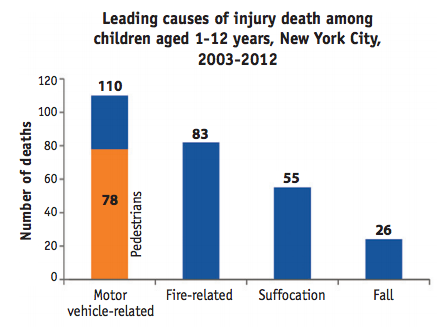Each year the Department of Health and Mental Hygiene reports on the top causes of injury-related death for children in New York City, and traffic crashes consistently top the list. That remains true in the newest report [PDF].
The DOH report draws on crash data from the medical examiner's office and DOT. From 2003 to 2012, an average of 44 kids aged 1 to 12 died annually from injury-related causes, including fires, suffocation, and falls, the report says. The largest share -- 40 percent -- were killed in traffic crashes. Of the 110 children aged 1 to 12 killed by motorists during that period, 78 were struck while walking.
Between 2009 and 2011, 23 kids aged 1 to 12 and 25 children aged 13 to 17 died in traffic crashes. Of those, 65 percent were struck by drivers while walking, 6 percent were hit while riding bikes, and 29 percent were riding in or driving a car.
Though boys, black children, and children from the poorest neighborhoods are a disproportionate share of the victims, traffic crashes were the top cause of such deaths for boys and girls across all races and ethnicities and all levels of neighborhood poverty.
The report says 19 of 31 kids aged 1 to 17 killed while walking between 2009 and 2011 were crossing against the traffic signal or crossing mid-block. But it does not specify how driver behavior or street design factored into those crashes. Instead, the report makes a general statement that driver behaviors “such as” inattention and failure to yield contributed to child pedestrian deaths. The report does not say what role driver speed, the leading cause of NYC traffic fatalities, played in crashes that killed children who were walking and biking.
The report includes boilerplate recommendations for adults to teach children how to walk and bike on city streets. The DOH advises drivers to obey the speed limit, yield to pedestrians, and watch for children.
Most important, the report says officials and community leaders should support expanded use of speed and red light cameras, safer street designs -- including bike lanes -- and enforcement of speeding and failure to yield.
“Injuries are often inaccurately seen as a result of ‘accidents’ that cannot be anticipated or avoided,” the report says. “However, most injuries follow patterns that can be predicted and potentially prevented.”







